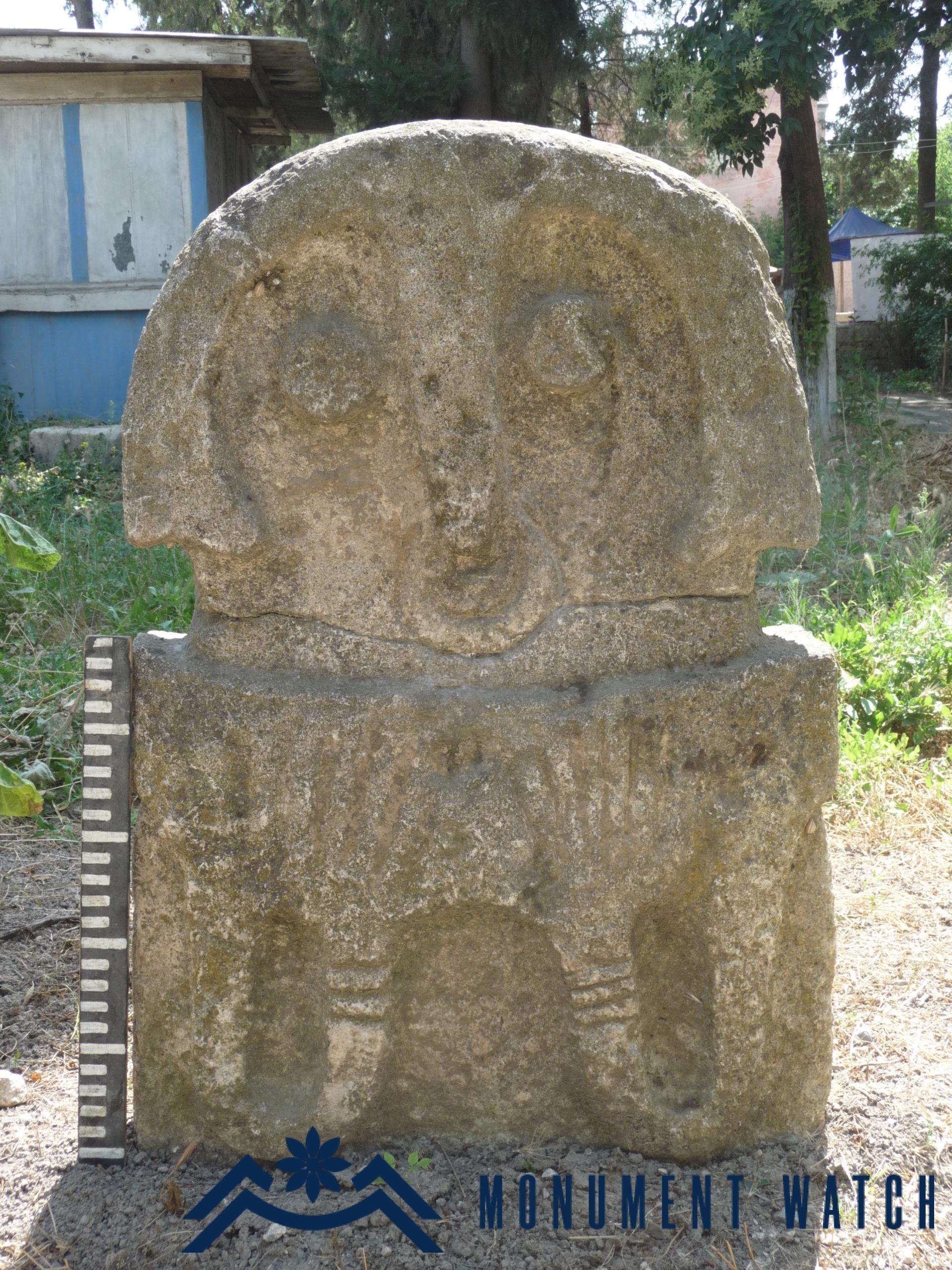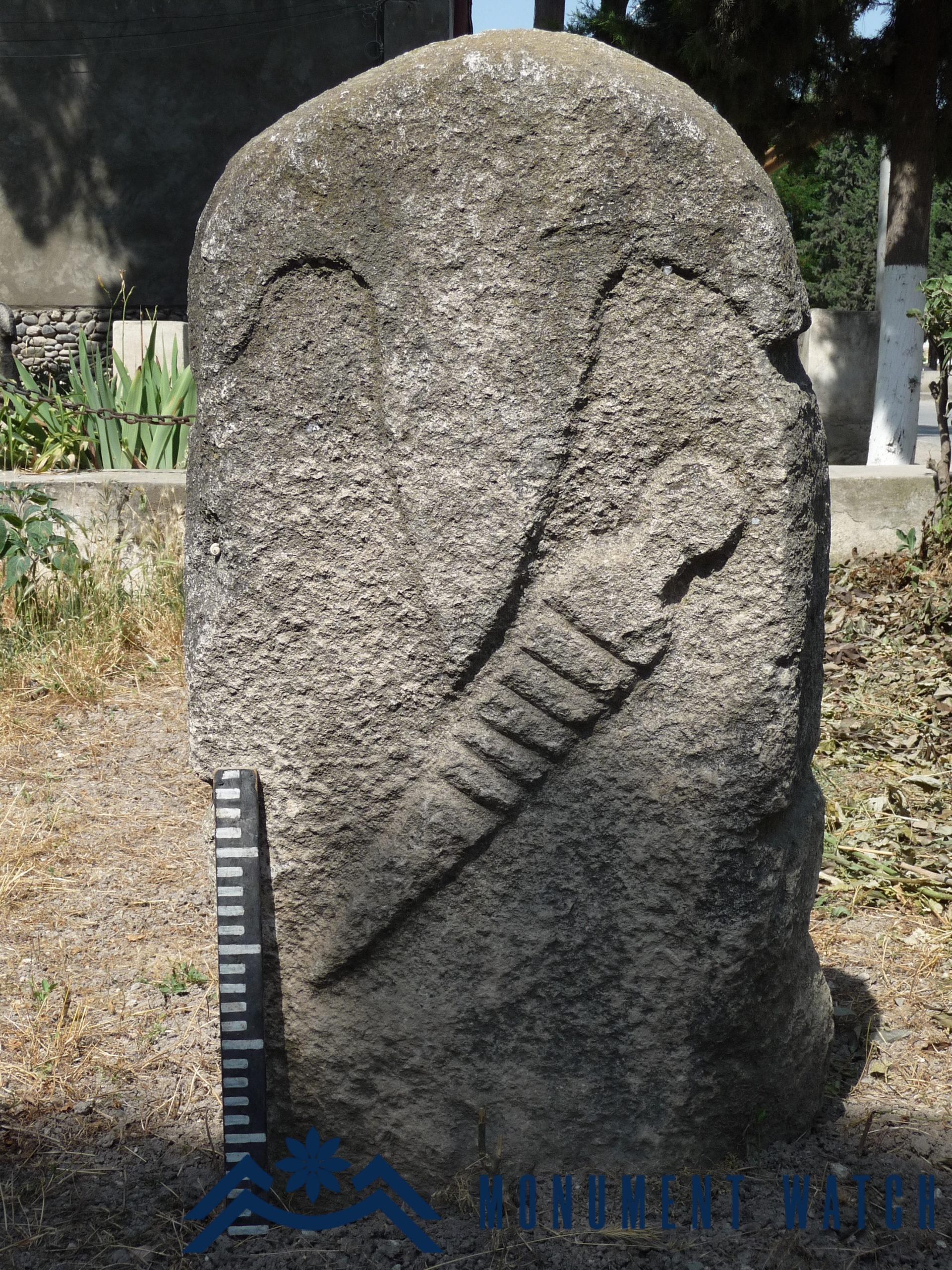The Anthropomorphic Obelisks of Artsakh
The anthropomorphic obelisks of Artsakh are one of the important components of the pre-Christian culture of the region. They are rectangular-shaped, flat longitudinal slabs, which are given a human appearance through volumetric and sculptural design. The main axis of their composition is the human body, the other components are pictorially and semantically valued as a result of the connection with it. These slabs are divided into three parts by two horizontal grooves, emphasizing the three parts of the body: the head, which occupies a little less than 1/3 of the whole obelisk, the waist and the lower part (Figs. 1, 2). The obelisks are about 30-60 cm wide, 120-140 cm, sometimes up to 2 m high, about 20 cm thick. All known obelisks are made of limestone (Yeranyan 2020, 246-252).
These areas were not sufficiently studied during the Soviet years for well-known reasons (Petrosyan, 2010, 137-148; Petrosyan, 2020, 79-90). The existing studies in their turn are obviously politicized. This also applies to the anthropomorphic obelisks, which some Azeri researchers have presented as Albanian, trying to view their prevalence, especially in Artsakh, as the existence of an Albanian ethnocultural substratum (Khalilov, 1987, 22; Vaidov, Geishev, Guliev, 1974, 446-447). Therefore, the study of these monuments, the examination of the issues of their clear chronology and ethno-cultural affiliation is not only of scientific interest, but also gives an opportunity to reject the Azerbaijani falsifications.
The obelisks became known by separate examples in the 60s of the last century, but their technical, pictorial, semantic examination, their chronology and possible ethnic belonging problems remained unspecified, and often simply unsolved. As a result of the Artsakh liberation war, new opportunities were created for the study of the ancient history and culture of the region. The physical accessibility of the anthropomorphic obelisks was the essential reality and circumstance that enabled the possibility of their detailed description, measurement, photographing, as well as the study of the historical and cultural environment.
In recent years, sometimes, and more often after the Second Artsakh War, some Azeri researchers criticize not the approaches and ideas related to the study of the obelisks, but in general the fact of their study and excavations conducted in the environs of the latter. According to official information, they even applied to the Prosecutor’s Office of Azerbaijan to initiate a criminal case against archaeologists working in the area of Nor Karmiravan village of Martakert region, among archaeologists who have worked in Artsakh for the last three decades[1].
It should be noted that during the research and excavation of these obelisks in Artsakh, all the laws of Artsakh were respected, the excavations were carried out at the invitation of the local authorities, and the obtained results were developed keeping all the methodological principles. Such destructive behavior of Azerbaijani researchers suggests that the study of obelisks is not of scientific interest to them and that political inappropriate approaches are more important to them. Given the fact that most of the obelisks remained under the control of the Azerbaijani armed forces after the trilateral statement signed on November 10, their future fate is in a problematic situation.
Bibliography
- Petrosyan 2010 – Petrosyan H., Cultural ethnocide in Artsakh (mechanism of extortion of cultural heritage), state terrorism of Azerbaijan and the policy of ethnic cleansing against Nagorno Karabakh, Shushi, pp. 137-148 (in Arm.). Petrosyan 2020 – Ethnocide in Artsakh: The Mechanisms of Azerbaijan’s Usurpation of Indigenous Armenian Cultural Heritage, Cultural Heritage. Experiences & Perspectives in International Context, Proceedings of the ROCHEMP center international conference, 23rd- 24th of January 2020, Yerevan, pp. 79-90.
- Yeranyan 2020 – Yeranyan N. 2020, Main Results of the Study of Anthropomorphic Stelae in Artsakh, Archaeology of Armenia in regional context, Yerevan, 246-252.
- Ваидов P. Геюшев Р. Гулиев Н. Новые находки каменных баб в Азербайджане, АО 1973 года, Москва, Наука, 1974, с. 446-447.
- Халилов М. Каменные изваяния Азербайджана (IVв. до н. э. – VII в. н. э. .), Автореф. канд. исторических наук, Ереван, 1987, 22 с.
[1] https://apa.az/az/incesenet-haqqinda/Arxeoloq-Arsax-sozunun-Dadivng-monastirinin-v-Xacin-knyazliginin-ermnilr-qtiyyn-aidiyyti-yoxdur-colorredMUSAHIBcolor-615839?fbclid=IwAR2cyHo3wbk7WEvREeamlPNUTUribGlonaSb4n-xd6cU_y19QMZvPwVYz30

